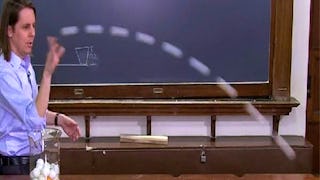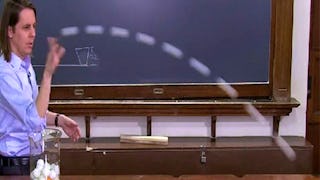An introduction to physics in the context of everyday objects.



How Things Work: An Introduction to Physics

Instructor: Louis A. Bloomfield
Top Instructor
274,020 already enrolled
(2,993 reviews)
Skills you'll gain
Details to know

Add to your LinkedIn profile
8 assignments
See how employees at top companies are mastering in-demand skills


Earn a career certificate
Add this credential to your LinkedIn profile, resume, or CV
Share it on social media and in your performance review

There are 8 modules in this course
Start here!
What's included
1 video2 readings1 assignment
Professor Bloomfield examines the principle of inertia through skate boarding. Objects at rest tend to remain at rest while objects in motion, tend to remain in motion. Why does a stationary skater remain stationary? Why does a moving skater tend to continue moving? How can we describe the fluid, effortless motion of a coasting skater? How does a skater start, stop, or turn? Why does a skater need ice or wheels in order to skate? Physics concepts covered include Newton's first and second laws and 5 physical quantities: position, velocity, acceleration, force, and mass.
What's included
7 videos1 assignment
Professor Bloomfield examines the physics concepts of gravity, weight, constant acceleration, and projectile motion working with falling balls.
What's included
8 videos1 assignment
Professor Bloomfield examines the physics concepts of Newton's third law including conserved quantities, support forces, work, energy, and mechanical advantage working with ramps.
What's included
7 videos1 assignment
Professor Bloomfield illustrates the physics concepts of rotational versus translational motion, Newton's law of rotation, and 5 physical quantities: angular position, angular velocity, angular acceleration, torque, and rotational mass using seesaws.
What's included
8 videos1 assignment
Professor Bloomfield illustrates the physics concept of frictional forces through experiments with wheels.
What's included
8 videos1 assignment
Professor Bloomfield examines the physics concepts of momentum, impulse, angular momentum, angular impulse, and the relationship between potential energy and force using bumper cars.
What's included
7 videos1 assignment
This is the final exam.
What's included
1 video1 assignment
Instructor

Offered by
Recommended if you're interested in Physics and Astronomy

The Hong Kong University of Science and Technology

Rice University

The Hong Kong University of Science and Technology

Rice University
Why people choose Coursera for their career




Learner reviews
2,993 reviews
- 5 stars
86.09%
- 4 stars
10.52%
- 3 stars
2.03%
- 2 stars
0.50%
- 1 star
0.83%
Showing 3 of 2993
Reviewed on Jun 21, 2017
Great introduction to Physics. I use the concepts taught in this course frequently in everyday life. Professor Bloomfield explains concepts very clearly without getting overly mathematical.
Reviewed on Jun 6, 2021
Great course to do for someone who has just started to learn physics. Prof. Bloomfield has really given his everything in this course. Highly recommended for those who have interest in physics.
Reviewed on May 7, 2020
Lou Bloomfield is very instructor , overall course is an amazing and quick revision to all the basic things of physics .The video length should be little shorter , overall its an amazing course .

Open new doors with Coursera Plus
Unlimited access to 10,000+ world-class courses, hands-on projects, and job-ready certificate programs - all included in your subscription
Advance your career with an online degree
Earn a degree from world-class universities - 100% online
Join over 3,400 global companies that choose Coursera for Business
Upskill your employees to excel in the digital economy
Frequently asked questions
Access to lectures and assignments depends on your type of enrollment. If you take a course in audit mode, you will be able to see most course materials for free. To access graded assignments and to earn a Certificate, you will need to purchase the Certificate experience, during or after your audit. If you don't see the audit option:
The course may not offer an audit option. You can try a Free Trial instead, or apply for Financial Aid.
The course may offer 'Full Course, No Certificate' instead. This option lets you see all course materials, submit required assessments, and get a final grade. This also means that you will not be able to purchase a Certificate experience.
When you purchase a Certificate you get access to all course materials, including graded assignments. Upon completing the course, your electronic Certificate will be added to your Accomplishments page - from there, you can print your Certificate or add it to your LinkedIn profile. If you only want to read and view the course content, you can audit the course for free.
You will be eligible for a full refund until two weeks after your payment date, or (for courses that have just launched) until two weeks after the first session of the course begins, whichever is later. You cannot receive a refund once you’ve earned a Course Certificate, even if you complete the course within the two-week refund period. See our full refund policy.
More questions
Financial aid available,

